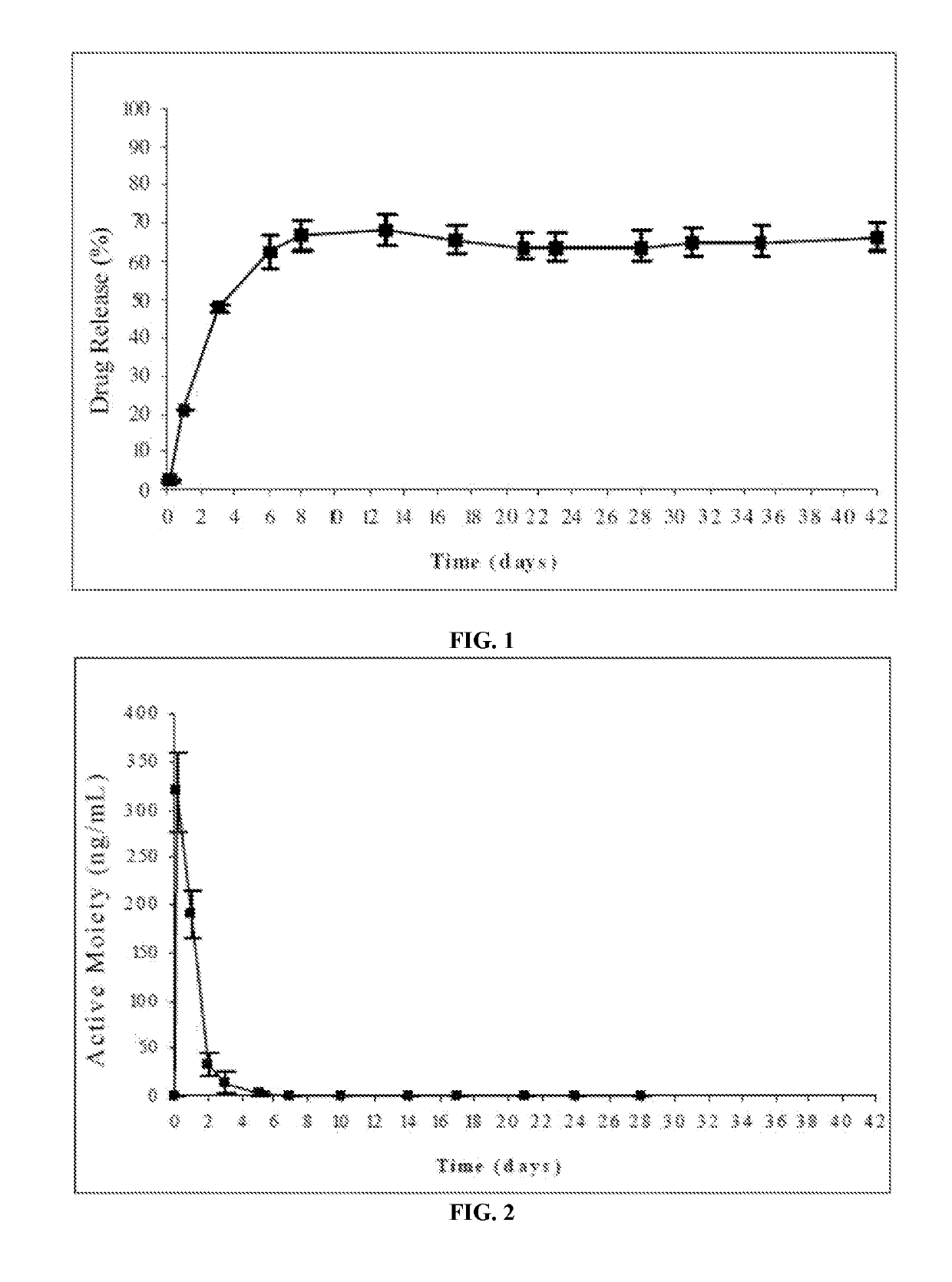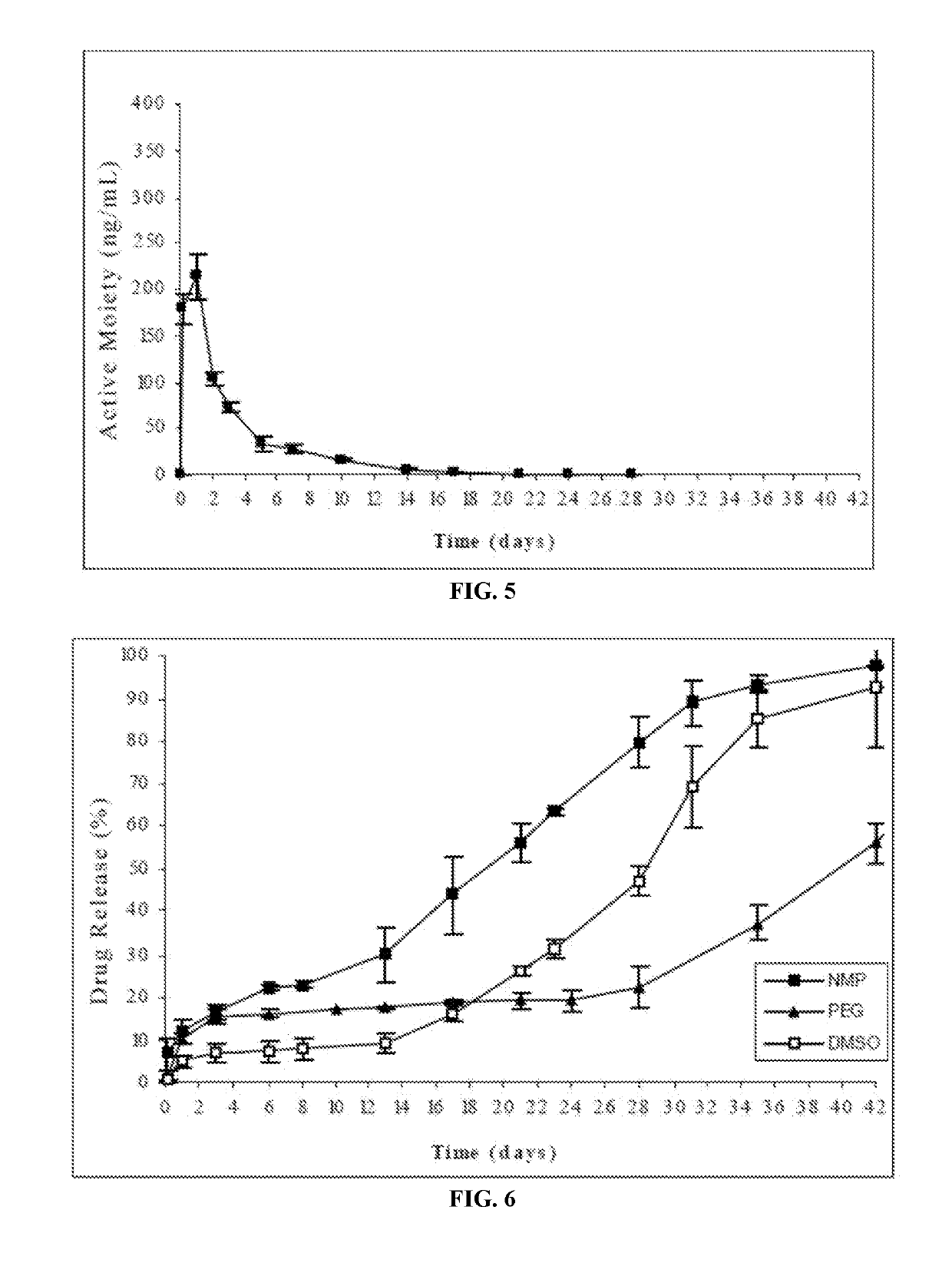Antipsychotic Injectable Depot Composition
a technology of depot composition and antipsychotics, which is applied in the direction of pharmaceutical non-active ingredients, pharmaceutical delivery mechanisms, organic active ingredients, etc., can solve the problems of promoting the occurrence of psychotic episodes and crises, affecting the patient's mood, and irregular or inconvenient treatment, so as to achieve constant and effective plasma levels, easy production method, and convenient effect of production
- Summary
- Abstract
- Description
- Claims
- Application Information
AI Technical Summary
Benefits of technology
Problems solved by technology
Method used
Image
Examples
example 1
Study of Different Water-Soluble Solvents with Different Dipole Moment
[0182]In the present example, the composition of the implantable formulation was as follows:
[0183]
Compo- Compo-Solvent sition 1sition 2dipoleIngredientAmount (mg)moment (D)Resomer ®RG503 (polymer)100100Risperidone2525Dimethyl sulfoxide (solvent)233.3—3.961,4-dioxane (solvent)—233.30.45RG503, 50:50 lactic / glycolic acid polymer (Boehringer Ingelheim)
[0184]The risperidone-implantable formulation was prepared by completely dissolving the polymer in either of the cited water-miscible solvents having different dipole moment (DMSO or 1,4-dioxane) and subsequently suspending the drug in said polymeric solution.
In Vitro Release Profile:
[0185]The risperidone release from the formulations of this example was evaluated according to the following procedure: the amount of formulation corresponding to 25 mg of risperidone was injected from prefilled syringes equipped with 21G needles into flasks followed by careful addition of a...
example 2
Study of Solvents with a High Solubility for Risperidone
[0187]In the present example, the composition of the implantable formulation was as follows:
[0188]
IngredientAmount (mg)Resomer ®RG752S (polymer)100Risperidone25Benzyl alcohol (solvent)233.3RG752S, 75:25 lactic / glycolic acid polymer (Boehringer Ingelheim)
[0189]The risperidone-implantable formulation of this example was prepared by completely dissolving the polymer in the water-miscible solvent having a high solubility for risperidone (benzyl alcohol) and subsequently suspending the drug in said polymeric solution.
In Vitro Release Profile:
[0190]The release of risperidone from the formulation was evaluated according to the following procedure: the amount of formulation corresponding to 25 mg of risperidone was injected from prefilled syringes equipped with a 21G needle into flasks having a pre-warmed release medium. The release medium was 250 ml phosphate buffer, pH=7.4. The flasks were then placed into an oven at 37° C. and kept ...
example 3
Study of Solvents with Different Solubility for Risperidone
[0194]In the present case, the risperidone implantable formulation was prepared by completely dissolving the polymer Resomer® RG503 (RG503, 50:50 lactic / glycolic acid, Boehringer Ingelheim) in different solvents (NMP, PEG and DMSO) in which risperidone exhibits intermediate to low solubility (in all cases below 65 mg / ml) and subsequently suspending the risperidone in the respective solvent.
[0195]
Compo- Compo-Compo-sition 1sition 2sition 3(DMSO)(NMP)(PEG300)IngredientAmount (mg)Risperidone252525Resomer ®RG503 (polymer)10010066.6DMSO233.3——NMP—233.3—PEG——266.7Risperidone solubility: 62.5 mg / mL in NMP; 9.5 mg / mL in DMSO; 8.2 mg / mL in PEG300
In Vitro Release Profile:
[0196]The risperidone release from the formulations of this example was evaluated according to the following procedure: the amount of formulation corresponding to 25 mg of risperidone was injected from prefilled syringes equipped with a 21G needle into flasks followed...
PUM
| Property | Measurement | Unit |
|---|---|---|
| size distribution | aaaaa | aaaaa |
| size | aaaaa | aaaaa |
| particle size distribution | aaaaa | aaaaa |
Abstract
Description
Claims
Application Information
 Login to View More
Login to View More - R&D
- Intellectual Property
- Life Sciences
- Materials
- Tech Scout
- Unparalleled Data Quality
- Higher Quality Content
- 60% Fewer Hallucinations
Browse by: Latest US Patents, China's latest patents, Technical Efficacy Thesaurus, Application Domain, Technology Topic, Popular Technical Reports.
© 2025 PatSnap. All rights reserved.Legal|Privacy policy|Modern Slavery Act Transparency Statement|Sitemap|About US| Contact US: help@patsnap.com



